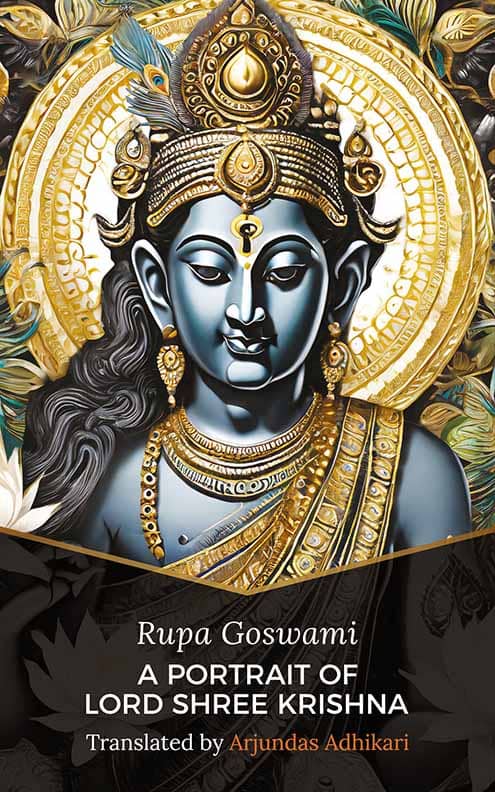
A playhouse for mortals should be made sixty four cubits (thirty two yards) in length, and thirty two cubits (sixteen yards) in breadth.
No one should build a playhouse bigger than this, because a play produced in a larger theatre will not be properly expressive. In a bigger playhouse, utterances will lose euphony due to being indistinct to audience members who are further from the stage.
Besides this, if the playhouse is too big, the expressions on the faces of the actors (so key to dramatic representation) may not be distinctly visible to everyone.
Natyashastra 2.17-20
The four principal means of Dramatic Representation (abhinaya) in Hindu, or Sanskrit drama, admirably compensate for the minimalist stage set or painted scenery involved. Sanskrit dramas such as Vidagdha Madhava, aka, A Portrait of Lord Shree Krishna, by Rupa Goswami, characteristically avoid stark realism, and instead capitalise on an audience’s scope for imagination and fancy. The four methods of communicating the meaning of a drama, and of inspiring sentiments, are:
- Actors’ gestures
- Actors’ speeches
- Actors’ costumes
- Actors’ temperaments
In Sanskrit drama in performance, for there to be maximum impact of these kinds of dramatic representation on an audience, proximity with said audience, is vital. This is why the above notes on theatre construction from the Natyashastra advocate building theatre-houses that accommodate no more than about four hundred people.
The Natyashastra was the template of directions for staging such a Sanskrit drama as Vidagdha Madhava, and what follows is a selection of performance-related instructions from it, that provide an idea of the level of skill and proficiency that were involved in ensuring that the performance was of an acceptable and credible standard:
The beauty that results from the slightly careless placing of garlands, clothes, ornaments and unguents, is called vicchitti (dishabille).
Natyashastra 24.16
The midday sun is to be indicated by looking upward with half-shut eyes, and the rising or the setting sun by a representation of the idea of depth.
NS 26.8
On exit, an actor should leave the place (house) by the very door used for entering. If he is to re-enter, his second exit should be made through the door through which other actors have entered.
NS 14.12-15
Envy arises in a person who is displeased to see other people’s good fortune, wealth, intelligence and exuberant sportiveness. It is to be represented by distortion of the face, turning away, decrying others’ virtues and manifest hatred towards them.
NS 7.36-7
Costumes of wandering ascetics, great sages and the like should be made, whenever necessary, with dark red cloth.
NS 23.120
Armours, shields, banners, hills, palaces, gods, caves, horses, elephants, aerial cars and houses can be made from cut bamboo and coverings of painted cloth to represent their likeness.
NS 23.190-192
A man filled with apprehension … constantly looks sideways.
NS 7.35
Light intoxication in the case of a high-brow person is characterised by a happy face, slightly faltering words, and delicately unsteady gate.
NS 7.41
To indicate anything audible or visible, whether it relates to the speaker or to the person spoken to, or anyone else, one should point to the ears and eyes respectively.
NS 26.14
One should show anger against control by superiors with slightly downcast eyes, wiping off slight perspiration and an absence of any violent movement.
NS 7.17
A discouraged man is represented with eyes brimming with tears and face distressed by heavy breathing. He should appear like a yogi absorbed in meditation.
NS 7.30
Fear arising from frightening objects should be represented on stage by actors with slackened limbs and suspended movements of the eyes.
NS 7.24
Joy is to be represented on stage by brightness of the eyes and face, loving words, embrace, delicate movements and perspiration.
NS 7.62
When the iinner idea of the playwright is made to pervade the mind of the spectators by means of words, gestures, costume and representation of temperament, the state elicited in the spectators is called bhava.
NS 7.2
Arjundas Adhikari

